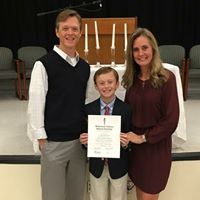Richard T Kirkman
age ~90
from Waterville, OH
- Also known as:
-
- Richard E Kirkman
- Richard T Kirman
- Richar Kirkman
- Thomas R Kirkman
- Dick T Kirkman
- Rick T Kirkman
- Robert Kirkman
- Kirkman Richar
Richard Kirkman Phones & Addresses
- Waterville, OH
- 4209 Waterbend Dr, Maumee, OH 43537 • (419)8678002
- 94 Mallard Run, Maumee, OH 43537 • (419)8930302
- Toledo, OH
- 4209 Waterbend Dr E, Maumee, OH 43537 • (419)3502263
Work
-
Position:Service Occupations
Education
-
Degree:Bachelor's degree or higher
Emails
Us Patents
-
Apparatus For Forming Glass Containers
view source -
US Patent:41370619, Jan 30, 1979
-
Filed:Mar 7, 1977
-
Appl. No.:5/775132
-
Inventors:James D. Mallory - Maumee OH
Richard T. Kirkman - Maumee OH -
Assignee:Owens-Illinois, Inc. - Toledo OH
-
International Classification:C03B 916
-
US Classification:65232
-
Abstract:Apparatus for forming glass containers by the blow and blow process in which a parison mold having a plurality of cavities is centrally positioned relative to a pair of blow molds having a plurality of cavities. The parisons are formed with their necks down in the parison mold from a charge of glass delivered to each cavity. Vacuum is applied to the neck area of the mold to form the finish portion of the container. A neck pin is pulled and air under pressure is fed to the interior of the area from which the neck pin is drawn to expand the glass within the parison mold at a continuous rate until the glass within the parison mold comes in contact with a baffle which closes the upper end of the parison mold. The parison mold is then opened and the parisons are transferred alternately from the parison mold to the blow molds where they are expanded into final shape. During the transfer of the parisons from the parison mold to the blow mold, air under pressure is maintained within the hollow interior of the parison.
-
Method For Forming Glass Containers
view source -
US Patent:40946568, Jun 13, 1978
-
Filed:Mar 7, 1977
-
Appl. No.:5/775131
-
Inventors:Robert D. Colchagoff - Toledo OH
Paul W. Fortner - Toledo OH
Richard T. Kirkman - Maumee OH
Thomas J. Naughton - Toledo OH
George Zimmerman - Sylvania OH -
Assignee:Owens-Illinois, Inc. - Toledo OH
-
International Classification:C03B 926
-
US Classification:65 81
-
Abstract:Method for forming glass containers by the blow and blow process in which a parison mold having a plurality of cavities is centrally positioned relative to a pair of blow molds having a plurality of cavities. The parisons are formed with their necks down in the parison mold from a charge of glass delivered to each cavity. Vacuum is applied to the neck area of the mold to form the finish portion of the container. A neck pin is pulled and air under pressure is fed to the interior of the area from which the neck pin is drawn to expand the glass within the parison mold at a continuous rate until the glass within the parison mold comes in contact with a baffle which closes the upper end of the parison mold. The parison mold is then opened and the parisons are transferred alternately from the parison mold to the blow molds where they are expanded into final shape. During the transfer of the parisons from the parison mold to the blow mold, air under pressure is maintained within the hollow interior of the parison.
-
Method And Apparatus For Forming Glass Containers
view source -
US Patent:41915488, Mar 4, 1980
-
Filed:May 17, 1978
-
Appl. No.:5/906707
-
Inventors:John M. Fortner - Whitehouse OH
Richard T. Kirkman - Maumee OH -
Assignee:Owens-Illinois, Inc. - Toledo OH
-
International Classification:C03B 936
-
US Classification:65 79
-
Abstract:Method and apparatus for forming glass containers by the blow and blow process in which a parison mold and blow mold are positioned relative to each other, such that parisons can be transferred by an invert arm. The parisons are formed with their necks down in the parison mold from a charge of glass delivered thereto, and vacuum is applied to the neck mold to settle the molten glass in the neck mold about a special neck pin to thereby form the finish portion of the container. The neck pin is pulled and counterblow of the charge into parison form is accomplished and the parison is transferred from the parison mold to the blow mold where it is expanded into final shape. The parison mold is coated with a "solid film lubricant" which provides a surface that has an insulating effect and requires less "swabbing" over its useable life. A plunger that has a tip that produces less heat removal for the time it is in contact with the charge or gob of glass is used and purging of the vacuum passages in the plunger is carried out each cycle.
-
Multiple Gob Glass Feeder System And Method Of Operation
view source -
US Patent:43057470, Dec 15, 1981
-
Filed:Jul 7, 1980
-
Appl. No.:6/166224
-
Inventors:Richard T. Kirkman - Maumee OH
James E. Serman - Temperance MI -
Assignee:Owens-Illinois, Inc. - Toledo OH
-
International Classification:C03B 708
-
US Classification:65128
-
Abstract:A molten glass feeder system and method of controlling the flow of glass through the feeder to deliver a plurality of uniform, molten glass gobs. The feeder has a heavy-walled bowl structure and a heavy-walled bottom transitional member mounted within the lower region of the feeder bowl, the transitional member having substantial height with a circular passageway at its upper region and an elongated slot passageway at its lower region, and an elongated discharge orifice member having a plurality of three or more, and preferably three to six, discharge orifices in lineal alignment with the elongated slot passageway. The feeder permits the simultaneous formation and delivery, when coupled with suitable glass shearing mechanism, of more uniform plural glass gobs having similar weight, temperature and heat characteristics to multiple-cavity gob-fed glass forming machines.
Wikipedia

William Lacy
view sourceWith him suffered Blessed Richard Kirkman, born at Addingham, in the West Riding. He arrived at Douai in 1577 and, after the transference of the English ...
Resumes

Richard Kirkman
view source
President
view source
Richard Kirkman
view sourceVehicle Records
-
Richard Kirkman
view source -
Address:4209 Waterbend Dr E, Maumee, OH 43537
-
VIN:JHLRE48547C068846
-
Make:HONDA
-
Model:CR-V
-
Year:2007
Youtube
Googleplus

Richard Kirkman

Richard Kirkman

Richard Kirkman
Work:
Home Inspection Plus - Owner
About:
I'm an ASHI home inspector and owner of Home Inspection Plus. I've done 750+ professional, fee-paid home inspections throughout the Central Arkansas area. I'm an ASHI Certified inspector a...

Richard Kirkman
Myspace

Richard Kirkman
view source
Richard Kirkman
view source
Richard Kirkman
view source
Richard Kirkman
view source
Richard Kirkman
view source
Richard Kirkman
view source
Richard Kirkman
view source
Richard Kirkman
view sourceClassmates

Richard Kirkman | Halland...
view source
Hallandale High School, H...
view sourceGraduates:
Richard Kirkman (1980-1984),
Lucy Cardenas (1996-2000),
Lisa Williams (1982-1986),
Michael Jordan (1989-1993)
Lucy Cardenas (1996-2000),
Lisa Williams (1982-1986),
Michael Jordan (1989-1993)
Get Report for Richard T Kirkman from Waterville, OH, age ~90








